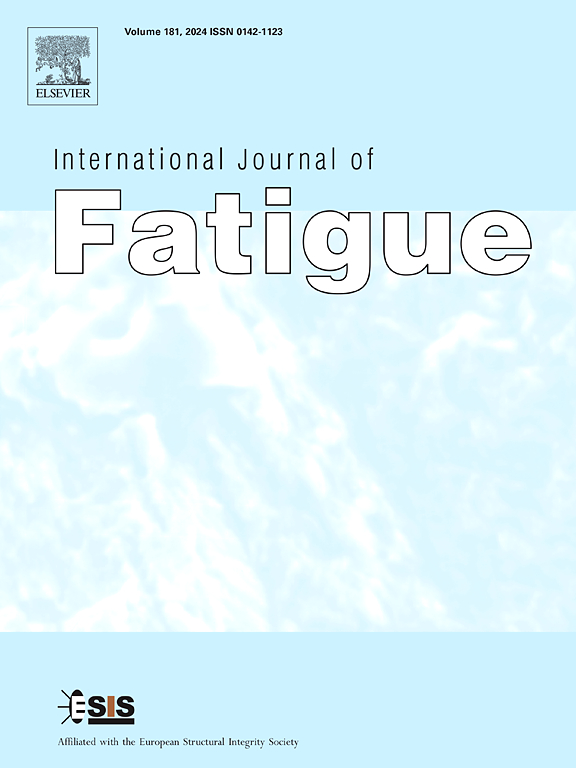未经和热处理的WAAM ER70S-6碳钢疲劳裂纹扩展
IF 5.7
2区 材料科学
Q1 ENGINEERING, MECHANICAL
引用次数: 0
摘要
研究了未经处理和热处理的WAAM ER70S-6碳钢的疲劳裂纹扩展行为。沿不同方向(垂直和水平)从打印墙体上提取试样,在两种应力比(R=0.05和R=0.25)下进行i型加载试验。使用数字图像相关(DIC)测量裂纹闭合。未经处理的材料显微组织主要由多边形铁素体和晶间片层珠光体组成。热处理后,珠光体分解,使铁素体生长,硬度降低。载荷比通过裂纹闭合程度的变化影响疲劳裂纹扩展速率。然而,相对于打印层取向的加载方向对裂纹扩展速率没有显著影响。通过扫描电镜观察断口表面,确定了不同加载方向和材料条件下疲劳裂纹扩展的主要机制。断口分析揭示了一种混合断裂机制,其特征是在较硬的富含珠光体的区域出现解理,而在较软的铁素体主导区域出现疲劳裂纹扩展条纹。细小的制造缺陷,如夹杂物和气孔,也被观察到。测试的WAAM碳钢表现出略低于类似等级的传统钢的性能,与WAAM ER70S-6碳钢的现有文献密切相关。本文章由计算机程序翻译,如有差异,请以英文原文为准。
Fatigue crack growth of untreated and heat-treated WAAM ER70S-6 carbon steel
The paper addresses the fatigue crack growth behaviour of untreated and heat-treated WAAM ER70S-6 carbon steel. Specimens were extracted from the printed wall along different directions (vertical and horizontal) and tested under mode-I loading at two stress ratios ( and ). Crack closure was measured using Digital Image Correlation (DIC). The microstructure of the untreated material mainly consisted of polygonal ferrite and intergranular lamellar pearlite. After heat treatment, pearlite decomposed, allowing ferrite to grow and reducing hardness. The load ratio influenced fatigue crack growth rates due to variations in crack closure levels. However, the loading direction relative to the print layer orientation did not significantly affect the crack growth rate. Fracture surfaces were examined by scanning electron microscopy to identify the main fatigue crack growth mechanisms associated with the different loading orientations and material conditions. Fractographic analysis revealed a mixed fracture mechanism, characterised by cleavage in the harder pearlite-rich regions and fatigue crack propagation striations in the softer ferrite-dominant areas. Minor manufacturing defects, such as inclusions and porosity, were also observed. The tested WAAM carbon steel exhibited slightly lower performance than conventional steels of a similar grade, aligning closely with the existing literature for WAAM ER70S-6 carbon steel.
求助全文
通过发布文献求助,成功后即可免费获取论文全文。
去求助
来源期刊

International Journal of Fatigue
工程技术-材料科学:综合
CiteScore
10.70
自引率
21.70%
发文量
619
审稿时长
58 days
期刊介绍:
Typical subjects discussed in International Journal of Fatigue address:
Novel fatigue testing and characterization methods (new kinds of fatigue tests, critical evaluation of existing methods, in situ measurement of fatigue degradation, non-contact field measurements)
Multiaxial fatigue and complex loading effects of materials and structures, exploring state-of-the-art concepts in degradation under cyclic loading
Fatigue in the very high cycle regime, including failure mode transitions from surface to subsurface, effects of surface treatment, processing, and loading conditions
Modeling (including degradation processes and related driving forces, multiscale/multi-resolution methods, computational hierarchical and concurrent methods for coupled component and material responses, novel methods for notch root analysis, fracture mechanics, damage mechanics, crack growth kinetics, life prediction and durability, and prediction of stochastic fatigue behavior reflecting microstructure and service conditions)
Models for early stages of fatigue crack formation and growth that explicitly consider microstructure and relevant materials science aspects
Understanding the influence or manufacturing and processing route on fatigue degradation, and embedding this understanding in more predictive schemes for mitigation and design against fatigue
Prognosis and damage state awareness (including sensors, monitoring, methodology, interactive control, accelerated methods, data interpretation)
Applications of technologies associated with fatigue and their implications for structural integrity and reliability. This includes issues related to design, operation and maintenance, i.e., life cycle engineering
Smart materials and structures that can sense and mitigate fatigue degradation
Fatigue of devices and structures at small scales, including effects of process route and surfaces/interfaces.
 求助内容:
求助内容: 应助结果提醒方式:
应助结果提醒方式:


